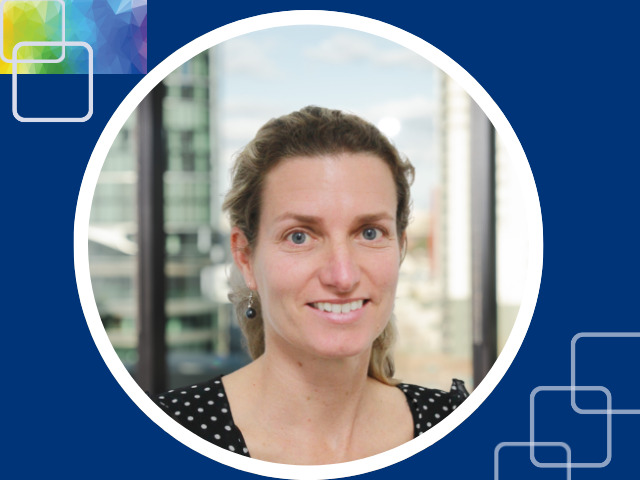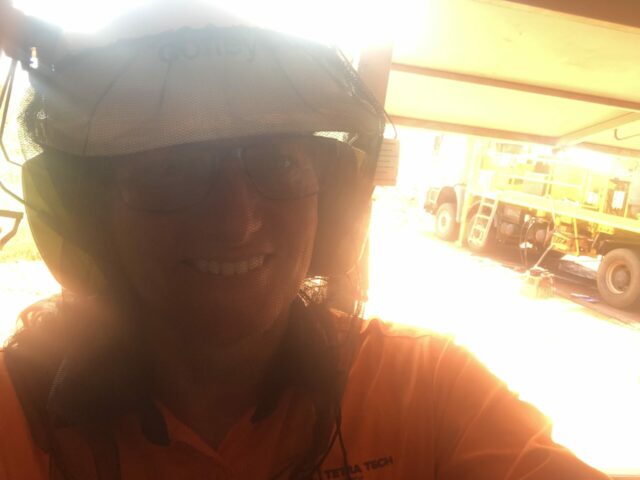
Con Spicer is a Senior Occupational Hygienist for Tetra Tech Coffey in Perth, Western Australia. She is a specialist in occupational hygiene risks and hazards, helping clients to address and minimise risks in the workplace and on project sites.
With experience across minerals and mining sectors and supporting private and government clients across commercial, health, and education sectors, she has spent the last 20 years focused on ensuring the health and wellbeing of people and projects.
Con holds a Graduate Diploma in Occupational Hygiene and Toxicology from Edith Cowan University, a Master of Ecotoxicology from the University of Technology Sydney and a Bachelor of Applied Science in Environmental Science from Charles Sturt University.
What led you to a career as an Occupational Hygienist?
I completed my undergraduate studies in environmental science, and early on in my career spent a lot of my time working in laboratories. I really wanted to pursue more field work outdoors, and I was first introduced to occupational hygiene when I swapped to work for an environmental consulting company in Sydney. It was here that I started branching into work, health, and safety. I was sent on field assignments to monitor for respirable silica. And that was more about the protection of workers, which really appealed to me.
At the time I had never heard of what an occupational hygienist was, so I sort of just ‘fell into it’… and the rest is history. It is an interesting observation, but talking to colleagues in the industry, you’ll find that most occupational hygienists don’t start out in this profession. They have mostly come from a science, engineering, or healthcare background.
What we all have in common is a strong focus in using science and technology to protect people’s health and educate them in ways which can help them stay healthy at work.
What type of work or services are you delivering?
Here in Western Australia, my work centres predominantly around servicing the mining sector, supporting exploration mining companies and helping them address risks in, and around their projects and to ensure they are meeting their legislative requirements.
It can be both new (Greenfields) or existing (Brownfield) sites, but more recently, it is mainly exploration phases.
We also perform work for education, construction, Defence, shipping and industry sectors.
What changes have you seen in occupational hygiene during your career?
The devastating increase of silicosis and black lung disease in Australia. There has been a big focus on respirable silica more recently, both in the engineered stone industry and tunnelling projects.
We’ve seen the workplace exposure standard decreased by half and it’s going to be halved again over the next three years. The same way asbestos has been regulated, it’s good to see that industry and the regulators are coming together to set those new benchmarks and standards for health. We will continue to see improvements in standards and guidelines and as always, are here to provide clients with the best possible support to implement them and keep their employees healthy.
What do you enjoy most about your work at Tetra Tech?
I really love what I do because of the diversity it offers. Working at Tetra Tech I get to meet lots of people from all walks of life. I could be speaking to a senior manager about recommending controls to implement and then I could go straight to site and be talking to a Boilermaker about how to use powered air purifying respirators.
It’s technical and we use quite a lot of equipment to monitor exposures to chemicals for example, dust, fumes gases; physical agents like light, heat; and biological agents such as mould or bacteria. Then there is the aspect of training clients, some lab work for asbestos, project management, report writing and reviewing, quoting, and what I really enjoy is mentoring WHS consultants who are coming up in their profession. So, every day seems different, and I love that.
There are not enough occupational hygienists in the world, so I feel quite comfortable with this role in that there’ll always be work available (laugh) and we are always in demand.
What are some of the major challenges and complexities you have addressed on a recent project?
I’m currently working with an exploration mining company for gold in Western Australia. Often where you find gold, you’ll have an association with arsenic, so potentially elevated levels of natural arsenic in the ground. Along with the conditions which are very dusty like drilling, there is the potential for workers to be exposed to arsenic.
One of the most interesting aspects of this project is the type of monitoring and testing we do. Our Tetra Tech team have put monitors on people to determine the level of arsenic in the workers’ breathing zone. And as arsenic travels through your urinary tract, we also take biological samples from workers to see if the arsenic has actually impacted their bodies already.
Arsenic can also be in your diet (albeit in very small amounts), we need to make sure that if they do come up with a positive sample, that it is actually from what they’re getting exposed to from the dust, rather than from their diet.
So, I ask the camp chefs to not put seafood on the menu for the three days before I come to site. That’s the level of detail we go to, to ensure our testing is as accurate as possible.
For our laboratory work, we can determine what’s organic arsenic and what’s inorganic arsenic. It’s the inorganic one that can cause harm and that’s what we can speciate for if the total arsenic result is elevated.
Remoteness of the site is a constraint, so we take samples on the last day we are flying out from camp and get them to laboratory as quickly as we can. So, while it is not an instant result, we aim to get the report to them as quickly as possible.
While it is a challenging project, it has been a fantastic example of where a proactive and vigilant client, consultants and employees have come together and are working to put proper plans in place to address the risk and then follow through with implementation and review of monitoring plans. It truly demonstrates again – everyone has a role to play in ensuring people stay healthy and well at work.
Other areas your team is focused on?
We do a lot of what is called fit testing. This is all about selecting the correct Personal Protection equipment (PPE) such as earplugs and respirators, for the tasks being performed by the employee.
It is so important that the PPE, especially the respirators that they’re wearing, protects them from exposure. That’s not easy in a mining environment where a lot of the guys are not clean shaven, but fit testing is making sure that they’ve got an effective seal and it’s an opportunity to train the worker in how to wear it correctly so that it’s functional.
While we mainly target engineering controls, for example, local exhaust ventilation or isolation, if we can’t eliminate or substitute a hazard, we also assist with administrative controls such as training on a range of topics such as noise, respirable silica and asbestos. My favourite one is noise awareness, as noise is one of industry’s most predominant hazards. Noise -induced hearing loss or tinnitus can have such an impact on the quality of life, yet it is totally preventable and unfortunately permanent once you’ve got it.
Our team can provide the right training, equipment and quality of care and support to clients as our focus is to protect worker health. We’ve got the technology and skill set to help. Our job is all about bringing it together, so it’s really rewarding when I go back on site and you see the people you fit tested and trained wearing their PPE and are adequately protected from exposure.
What considerations are included when working on projects in different geographic regions?
Occupational hygiene covers a broad spectrum of hazards, and this is reflective not only on the type of project we are working on but also the location and natural elements that we are addressing.
Here in Western Australia, we are delivering some different services when compared to my colleagues on the East Coast of Australia.
The team here are working with a lot of heavy-set minerals clients, in a processing or crushing environment, where there can be a multitude of air contaminants. But in a more concentrated, raw, native toxic kind of setting. Here we might deal with naturally occurring asbestos in the ground as well as in the built space.
So yes – location and type of client and projects play a big part in how we address the risks.
What would you say has been the most rewarding aspect of your career?
It has proven to be such a rewarding career for me, and over the past few years I have enjoyed giving back to the industry I work in. I have been fortunate to be invited a few times as an assistant lecturer at Edith Cowan University and I have also assisted the Australian Institute of Occupational Hygienists deliver the practical component of their Basic Principles in Occupational Hygiene Course in Western Australia.
It is an aspect of my role that I have really enjoyed. Right across Australia there is a shortage of Occupational Hygienists. I strongly encourage people from a science, health or engineering background who might be looking for a pivot in their career to explore occupational hygiene as a career path. It is a personally rewarding career where you can use your science knowledge in the best possible way – to keep people healthy in the workplace.
Connect with Con at Con.Spicer@tetratech.com

Pictured: Senior Occupational Hygienist Con Spicer performing WHS monitoring